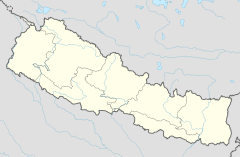Bardia National Park
| Bardiya National Park (बर्दिया राष्ट्रिय निकुञ्ज) | ||
|---|---|---|
| Indian rhinoceros in Bardia National Park | ||
|
|
||
| Location: | Nepal | |
| Surface: | 968 km² | |
| Founding: | 1988 | |
The Bardiya National Park is a national park in southwestern Nepal , in 1988 under the name of Royal Bardia National Park was established.
The 968 km² national park is located east of the Karnali River at an altitude of between 152 m in Nepal's Terai region and 1441 m in the Churia Mountains .
Together with the neighboring Banke National Park , the Bardiya National Park forms the Tiger Conservation Unit Bardiya-Banke , which extends over 2231 km² and comprises 1437 km² of protected area.
history
Nepal lost this region to British India in 1815 and got it back in 1860, in recognition of helping put down the Indian uprising of 1857 . Today the region is still called Naya Muluk - "New Land". In 1969 an area of 368 km² was declared the Royal Hunting Reserve , which was announced as the Royal Karnali Wildlife Reserve in 1976 and renamed the Royal Karnali Wildlife Reserve in 1982 . In 1984 the protected area was expanded to include the Babai River valley and in 1988 it was granted national park status.
In 1996 a 327 km² buffer zone was set up around the national park.
climate
The climate of the region is a subtropical monsoon climate . The rainy season falls between June and October, with a cool dry season from mid-October to February, which turns into a hot dry season in March.
vegetation
About 70% of the national park consists of Sal forest , the rest is open grassland, savannah and alluvial forest . Seven vegetation zones are distinguished: Salwälder, alluvial forests, hardwood forests, mixed forests from communities of Indian rosewood and Khair , forest savannas, Phantas and high grasslands.
The variety of plants includes 839 species, including 173 species of vascular plants .
Wildlife
The national park is home to populations of rare wild animals such as Bengal tigers , Barasingha deer , Asian elephants , stag goat antelopes , Ganges gaviale , marsh crocodiles and Ganges dolphins . In addition, there are Indian rhinos in the area that have been relocated from Chitwan National Park . Their number was around 35 animals in 2007. The population is declining due to poaching. In March 2008 only 22 animals were counted. In the spring 2015 census, 29 rhinos were found again. The number of elephants is also increasing; in 2002 there were about 60 animals. Other major species are leopard , wild boar , muntjac , hog deer , axis deer and nilgai . The park's rare bird species include the Sarus crane , the flag bustard and the bearded bustard . In total there are over 30 species of mammals and over 230 species of birds in the national park. There are also different types of snakes, lizards and fish.
Web links
Individual evidence
- ↑ a b T. C. Majupuria, R. Kumar: Wildlife, National Parks and Reserves of Nepal. S. Devi, Saharanpur and Tecpress Books, Bangkok 1998, ISBN 974-89833-5-8 .
- ↑ ED Wikramanayake, E. Dinerstein, JG Robinson, KU Karanth, A. Rabinowitz, D. Olson, T. Mathew, P. Hedao, M. Connor, G. Hemley, D. Bolze: Where can tigers live in the future? A framework for identifying high-priority areas for the conservation of tigers in the wild. In: J. Seidensticker, S. Christie, P. Jackson (Eds.): Riding the Tiger. Tiger conservation in human-dominated landscapes. Cambridge University Press, Cambridge 1999, ISBN 0-521-64835-1 , pp. 255-272.
- ↑ a b U. R. Bhuju, PR Shakya, TB Basnet, S. Shrestha: Nepal Biodiversity Resource Book. Protected Areas, Ramsar Sites, and World Heritage Sites ( Memento of March 1, 2012 in the Internet Archive ) (PDF file; 14.26 MB) International Center for Integrated Mountain Development, Ministry of Environment, Science and Technology, in cooperation with United Nations Environment Program, Regional Office for Asia and the Pacific, Kathmandu 2007, ISBN 978-92-9115-033-5 .
- ↑ a b c d Shova Thapa: Effectiveness of crop protection methods against wildlife damage: A case study of two villages at Bardia National Park, Nepal. In: Crop Protection. Volume 29, Issue 11, November 2010, pp. 1297–1304, doi: 10.1016 / j.cropro.2010.06.015 .
- ↑ E. Dinerstein: An ecological survey of the royal Karnali-Bardiya Wildlife Reserve, Nepal. Part I: Vegetation, modifying factors, and successional relationships. In: Biological Conservation. 15 (2), 1979, pp. 127-150.
- ↑ BK Talukdar, R. Emslie, SS Bist, A. Choudhury, S. Ellis, BS Bonal, MC Malakar, BN Talukdar, M Barua: Rhinoceros unicornis. In: IUCN 2011. IUCN Red List of Threatened Species. Version 2011.1. www.iucnredlist.org . Downloaded on June 16, 2011.
- ↑ DNPWC: ( page no longer available , search in web archives ) Rhino Count - 2008, Nepal . Department of National Parks and Wildlife Conservation, Kathmandu 2008.
- ↑ Rhino population up.Kantipur.com, May 5, 2015.
- ^ SR Bhatta: Efforts to conserve the Asian elephant in Nepal (PDF file; 377 kB). In: Gajah: Journal of the IUCN / SSC Asian Elephant Specialist. Group 25, 2006, pp. 87-89.
- ↑ P. Wegge, M. Odden, CP Pokharel, T. Storaas: Predator – prey relationships and responses of ungulates and their predators to the establishment of protected areas: a case study of tigers, leopards and their prey in Bardiya National Park, Nepal . In: Biological Conservation. 142, 2009, pp. 189-202.


